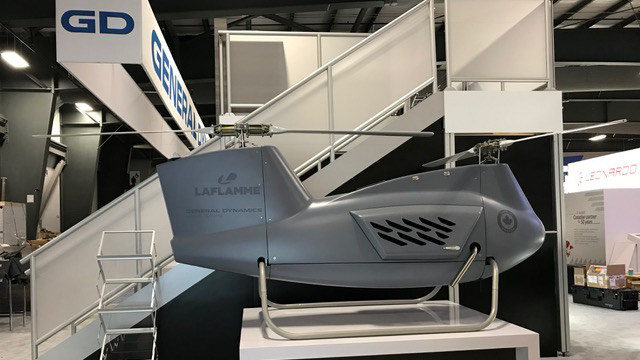GR66
Army.ca Veteran
- Reaction score
- 4,603
- Points
- 1,160
It's a seismic survey vessel - Ramform Titan (or a sister ship)What the heck is that supposed to be, anyway?

It's a seismic survey vessel - Ramform Titan (or a sister ship)What the heck is that supposed to be, anyway?
Captain Drew Graham (Director of Naval Requirements) recently did a Speakers Event for the Naval Association of Canada and had some interesting information to put forward to the public regarding the JSS and an unmanned aircraft program planned for it. All of the information is taken from his slideshow, that I will link at the bottom for anybody interested.
- Heavy lift aircraft, will be able to lift a single loaded pallet of supplies and conduct ISR.
- Will be operated aboard Protecteur class ships and primarily utilized for vertical replenishment.
- Largely automated, "pilotless" operations.
- Operated by specially trained UAV operators, which are send alongside aircraft when tasked.
- Currently unfunded, 2031 to 2033 introduction timeline.

LX-300 is shown as a potential example photograph in the slideshow.

Given the comparatively small dimensions of the LX300, I’m guessing there’s enough room to house them alongside 2 x CH-148 in the hanger? Or maybe there’s enough open space to launch and maintain them from a shipping container on the main deck? UAS are certainly useful as an additive capability alongside the helos, but it doesn’t seem worthwhile to lose the ASW, pax transfer, and larger payload capabilities of a helo if 1 x CH-148 needs to be given up to fit UAV in the hanger.Some more info on the LX300. Interesting option. - 180 kg payload.
Dimensions
- Length: 2.9 meters
- Height: 1.5 meters
- Width: 1.2 meters
- Rotor diameter: 2.8 meters (CH-148 = 17.7 meters and CH-146 = 14.88 meters)
- Empty weight: 190 kilograms
- Maximum takeoff weight: 300 kilograms
- Payload: Up to 90 kilograms
Endurance
- Can fly for up to 10 hours without a break
- Endurance depends on payload capacity
Speed
- Maximum cruising speed of 210 kilometers per hour
- Best endurance airspeed of 140 kilometers per hour
Propulsion
- Continental CD-155 engine
- Can use F-44 (JP-5), Jet A, Jet A-1, and other fuels
LX300 Remotely Piloted Helicopter - General Dynamics Mission Systems-Canada
A versatile multi-mission remotely piloted helicopter.gdmissionsystems.ca

General Dynamics and Laflamme Aero to Showcase LX300 Customizable Unmanned Helicopter at CANSEC 2019 - General Dynamics Mission Systems-Canada
General Dynamics Mission Systems–Canada will showcase Laflamme Aero’s LX300 Customizable Unmanned Helicopter – a Canadian-built, multi-mission and multi-role unmanned helicopter that can perform missions over land and sea – at CANSEC 2019.gdmissionsystems.ca
It might not matter… it might make sense to structure all 12 Wing deployments for the conceivable future around single aircraft, two crew, 12 hour deck cycle. Especially since there are fewer dets available than ships that can embark them. Use the extra space for whatever. We already had the conversation that 2nd line at sea is not really in the offing anyway.Given the comparatively small dimensions of the LX300, I’m guessing there’s enough room to house them alongside 2 x CH-148 in the hanger? Or maybe there’s enough open space to launch and maintain them from a shipping container on the main deck? UAS are certainly useful as an additive capability alongside the helos, but it doesn’t seem worthwhile to lose the ASW, pax transfer, and larger payload capabilities of a helo if 1 x CH-148 needs to be given up to fit UAV in the hanger.
That sort of work between UAS and helo is going to require an increase in support staff like SACs. It's great to bring in new toys, but if the people who enable you to operate the toys aren't considered, things can go off the rails pretty fast.It might not matter… it might make sense to structure all 12 Wing deployments for the conceivable future around single aircraft, two crew, 12 hour deck cycle. Especially since there are fewer dets available than ships that can embark them. Use the extra space for whatever. We already had the conversation that 2nd line at sea is not really in the offing anyway.
I already answered the kayak question, its clearly a boat as its centre of gravity (unloaded) is below its freeboard, which is the first deck or gunnel. The gunnel or first deck on a kayak is at the ring around your waist when you're seated in it.I think that's some nav archs coming up with a 'backronym' for the definition while ignoring exceptions to that rule (kayaks were already pointed out).
Globally 'vessels' is used in IMO and class rules in their definitions (which is all written by a lot of engineers, techs and other mariners), probably because ships/boats is all over the place, but I think generally ships are big, boats are small, with the context of what is 'big and small' changing over time as manufacturing change, what kind of vessel you are talking about etc, so neither of them have any accepted engineering definition.
The word “vessel” includes every description of water craft, including non-displacement craft, WIG craft and seaplanes, used or capable of being used as a means of transportation on water.
Really a shame we can't build another with that kind of efficiency improvement from JSS1 to JSS2. A little puzzled by how they reduced steel by 30% however...Here is a short video update on the future Protecteur released today. A bit of a walk around.
steel errors?Really a shame we can't build another with that kind of efficiency improvement from JSS1 to JSS2. A little puzzled by how they reduced steel by 30% however...
Yeah, the Scottish brogue was pretty thick, so you're probably right, I just misunderstood. There is no way they could have reduced steel by 30%!steel errors?
need subtitle's
Fitted for, but not with a superstructure?Yeah, the Scottish brogue was pretty thick, so you're probably right, I just misunderstood. There is no way they could have reduced steel by 30%!
Probably just better efficency cutting to reduce waste. Ship 1 each piece i bet was cut a little bit larger and then adjusted down to fit to be in the safe side.Really a shame we can't build another with that kind of efficiency improvement from JSS1 to JSS2. A little puzzled by how they reduced steel by 30% however...
Finally got the chance to sit down and watch this whole tour. Very impressive ship and set up. My 17 year old twins were even paying attention and expressed some interest in Navy life. That shows the power of exposure. More of this and you may just get more of a buy in, even from this generation.Here is another episode in the the series Go Bold, this time on the Asterix:
Really a shame we can't build another with that kind of efficiency improvement from JSS1 to JSS2. A little puzzled by how they reduced steel by 30% however...
Ye tha farst Scott to edmit spiking tha King's English.
